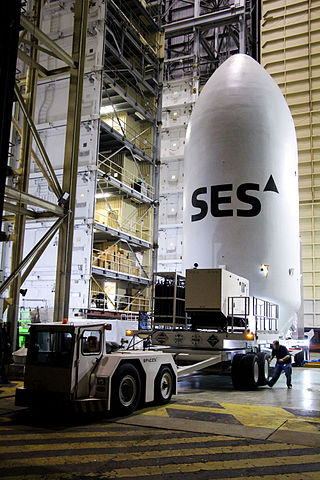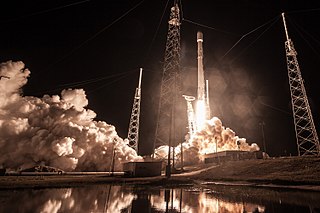
Ariane 5 is a retired European heavy-lift space launch vehicle developed and operated by Arianespace for the European Space Agency (ESA). It was launched from the Centre Spatial Guyanais (CSG) in French Guiana. It was used to deliver payloads into geostationary transfer orbit (GTO), low Earth orbit (LEO) or further into space. The launch vehicle had a streak of 82 consecutive successful launches between 9 April 2003 and 12 December 2017. Since 2014, Ariane 6, a direct successor system, is in development.

Cape Canaveral Space Force Station (CCSFS) is an installation of the United States Space Force's Space Launch Delta 45, located on Cape Canaveral in Brevard County, Florida.

Delta IV was a group of five expendable launch systems in the Delta rocket family introduced in the early 2000s. Originally designed by Boeing's Defense, Space and Security division for the Evolved Expendable Launch Vehicle (EELV) program, the Delta IV became a United Launch Alliance (ULA) product in 2006. The Delta IV was primarily a launch vehicle for United States Air Force (USAF) military payloads, but was also used to launch a number of United States government non-military payloads and a single commercial satellite.

Telesat, formerly Telesat Canada, is a Canadian satellite communications company founded on May 2, 1969. The company is headquartered in Ottawa.

Falcon 9 is a partially reusable medium-lift launch vehicle that can carry cargo and crew into Earth orbit, designed, manufactured and launched by American aerospace company SpaceX. It can also be used as an expendable heavy-lift launch vehicle. The first Falcon 9 launch was in June 2010. The first Falcon 9 ISS commercial resupply mission to the ISS launched on 8 October 2012. In 2020 it became the first commercial rocket to ever launch humans to orbit and is currently the only such vehicle capable of doing so. It is the only U.S. rocket currently certified for transporting humans to the International Space Station. In 2022, it became the U.S. rocket with the most launches in history and with the best safety record, having suffered just one flight failure.
ORBCOMM is an American company that offers industrial internet and machine to machine (M2M) communications hardware, software and services designed to track, monitor, and control fixed and mobile assets in markets including transportation, heavy equipment, maritime, oil and gas, utilities and government. The company provides hardware devices, modems, web applications, and data services delivered over multiple satellite and cellular networks.

United Launch Alliance, LLC (ULA) is an American aerospace manufacturer, defense contractor and launch service provider that manufactures and operates a number of rocket vehicles that launch spacecrafts into orbits around Earth and other bodies in the Solar System.
TerreStar-1 is an American communications satellite which was operated by TerreStar Corporation. It was constructed by Space Systems/Loral, based on the LS-1300S bus, and carries E/F band transponders which will be used to provide mobile communications to North America. The signals are transmitted by an 18-metre (59 ft) reflector on the satellite. It had a launch mass of 6,910 kilograms (15,230 lb), making it the second most massive single satellite launched into a geosynchronous transfer orbit, and the second largest commercial communications satellite ever built. Its record as the most massive communication satellite was surpassed by Telstar 19V launched on Falcon 9 on July 21, 2018, with a mass of 7,076 kilograms (15,600 lb).

Telstar is the name of various communications satellites. The first two Telstar satellites were experimental and nearly identical. Telstar 1 launched on top of a Thor-Delta rocket on July 10, 1962. It successfully relayed through space the first television pictures, telephone calls, and telegraph images, and provided the first live transatlantic television feed. Telstar 2 was launched May 7, 1963. Telstar 1 and 2—though no longer functional—still orbit the Earth.

An autonomous spaceport drone ship (ASDS) is an ocean-going vessel derived from a deck barge, outfitted with station-keeping engines and a large landing platform, and is autonomously positioned when on station for a landing. Construction of the drone ships was commissioned by aerospace company SpaceX to allow recovery of launch vehicle boosters at sea for missions that do not carry sufficient fuel to return to the launch site after boosting spacecraft onto an orbital or interplanetary trajectory.

SpaceX CRS-15, also known as SpX-15, was a Commercial Resupply Service mission to the International Space Station launched 29 June 2018 aboard a Falcon 9 rocket. The mission was contracted by NASA and flown by SpaceX.

SES-9 is a geostationary communications satellite operated by SES S.A. It was launched from Cape Canaveral SLC-40 by a Falcon 9 Full Thrust launch vehicle on 4 March 2016.
A medium-lift launch vehicle (MLV) is a rocket launch vehicle that is capable of lifting between 2,000 to 20,000 kg by NASA classification or between 5,000 to 20,000 kilograms by Russian classification of payload into low Earth orbit (LEO). An MLV is between small-lift launch vehicles and heavy-lift launch vehicles.

The following is a timeline of important events in the history of private spaceflight, including important technical as well as legislative and political advances. Though the industry has its origins in the early 1960s, soon after the beginning of the Space Age, private companies did not begin conducting launches into space until the 1980s, and it was not until the 21st century that multiple companies began privately developing and operating launch vehicles and spacecraft in earnest.

Telstar 18V(Telstar 18 Vantage / APStar 5C) is a communication satellite in the Telstar series of the Canadian satellite communications company Telesat. T18V will be equipped with C and Ku-band transponders and operate from 138° East. At 7,060 kilograms (15,560 lb), it is the second-heaviest communication satellite ever launched, weighing slightly less than its sibling Telstar 19V.

USA-280 was a classified United States government satellite that was launched by SpaceX on 8 January 2018, on the 47th flight of the Falcon 9 rocket. The National Reconnaissance Office was in charge of the Zuma project, though its purpose has not been disclosed. In November 2017, Northrop Grumman stated that the launch "is a monumental responsibility and has taken great care to ensure the most affordable and lowest risk scenario for Zuma." The Wall Street Journal reported that the design was very sensitive to vibration and sudden shocks, and had a development cost approaching US$3.5 billion.
ICEYE Ltd. is a Finnish microsatellite manufacturer. ICEYE was founded in 2014 as a spin-off of Aalto University's University Radio Technology Department, and is based in Espoo.













